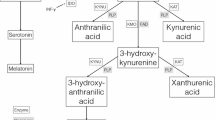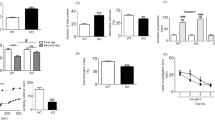Abstract
This study aims at determining serum levels of tryptophan and other metabolites of the kynurenine pathway in children with attention deficit hyperactivity disorder (ADHD) compared to healthy controls. Such metabolites interact with glutamate receptors in the central nervous system, potentially modulating mechanisms that are pivotal in ADHD and thus potentially representing peripheral biomarkers of the disorder. We measured serum levels of tryptophan and some metabolites of the kynurenine pathway in 102 children with ADHD and 62 healthy controls by liquid chromatography–tandem mass spectrometry (LC–MS/MS). As compared to healthy controls, children with ADHD showed a reduction in serum levels of anthranilic acid (−60%), kynurenic acid (−11.2%), and xanthurenic acid (−12.5%). In contrast, serum levels of tryptophan (+11.0%) and kynurenine (+48.6%) were significantly enhanced, and levels of quinolinic acid were unchanged in children with ADHD. In a logistic regression model, the presence of ADHD was predicted by low anthranilic acid and high tryptophan levels. These findings support the involvement of the kynurenine pathway in the pathophysiology of ADHD and suggest that anthranilic acid and tryptophan levels should be investigated as potential peripheral biomarker for ADHD.

Similar content being viewed by others
References
Kessler RC, Adler L, Barkley R et al (2006) The prevalence and correlates of adult ADHD in the United States: results from the National Comorbidity Survey Replication. Am J Psychiatry 163(4):716–723
Polanczyk G, de Lima MS, Horta BL, Biederman J, Rohde LA (2007) The worldwide prevalence of ADHD: a systematic review and metaregression analysis. Am J Psychiatry 164(6):942–948 (review)
American Psychiatric Association (2013) Diagnostic and statistical manual of mental disorders: DSM-5. American Psychiatric Association, Washington, D.C
Thapar A, Cooper M, Eyre O, Langley K (2013) What have we learnt about the causes of ADHD? J Child Psychol Psychiatry 54(1):3–16
Shaw P, Malek M, Watson B, Greenstein D, de Rossi P, Sharp W (2013) Trajectories of cerebral cortical development in childhood and adolescence and adult attention-deficit/hyperactivity disorder. Biol Psychiatry 4(8):599–606
Scassellati C, Bonvicini C, Faraone SV, Gennarelli M (2012) Biomarkers and attention-deficit/hyperactivity disorder: a systematic review and meta-analyses. J Am Acad Child Adolesc Psychiatry 51(10):1003–1019.e20
Bonvicini C, Faraone SV, Scassellati C (2017) Common and specific genes and peripheral biomarkers in children and adults with Attention-Deficit/Hyperactivity Disorder. World J Biol Psychiatry 18:1–52
Bonvicini C, Faraone SV, Scassellati C (2016) Attention-deficit hyperactivity disorder in adults: A systematic review and meta-analysis of genetic, pharmacogenetic and biochemical studies. Mol Psychiatry 21(7):872–884
Sasaki T, Hashimoto K, Oda Y, Ishima T et al (2015) Decreased levels of serum oxytocin in pediatric patients with Attention Deficit/Hyperactivity Disorder. Psychiatry Res 228(3):746–751
Taurines R, Grünblatt E, Schecklmann M et al (2011) Altered mRNA expression of monoaminergic candidate genes in the blood of children with attention deficit hyperactivity disorder and autism spectrum disorder. World J Biol Psychiatry 12(Suppl 1):104–108
Schwarcz R, Bruno JP, Muchowski PJ, Wu HQ (2012) Kynurenines in the mammalian brain: when physiology meets pathology. Nat Rev Neurosci 13(7):465–477
Parsons CG, Danysz W, Quack G et al (1997) Novel systemically active antagonists of the glycine site of the N-methyl-d-aspartate receptor: electrophysiological, biochemical and behavioral characterization. J Pharmacol Exp Ther 283(3):1264–1275
de Carvalho LP, Bochet P, Rossier J (1996) The endogenous agonist quinolinic acid and the non endogenous homoquinolinic acid discriminate between NMDAR2 receptor subunits. Neurochem Int 28(4):445–452
Fazio F, Lionetto L, Curto M et al (2015) Xanthurenic acid activates mGlu2/3 metabotropic glutamate receptors and is a potential trait marker for schizophrenia. Sci Rep 8(5):17799
Neale SA, Copeland CS, Salt TE (2014) Effect of VGLUT inhibitors on glutamatergic synaptic transmission in the rodent hippocampus and prefrontal cortex. Neurochem Int 73:159–165
Fazio F, Lionetto L, Molinaro G et al (2012) Cinnabarinic acid, an endogenous metabolite of the kynurenine pathway, activates type 4 metabotropic glutamate receptors. Mol Pharmacol 81(5):643–656
Turic D, Langley K, Mills S et al (2004) Follow-up of genetic linkage findings on chromosome 16p13: evidence of association of N-methyl-d aspartate glutamate receptor 2A gene polymorphism with ADHD. Mol Psychiatry 9(2):169–173
Aarsland TI, Landaas ET, Hegvik TA et al (2015) Serum concentrations of kynurenines in adult patients with attention-deficit hyperactivity disorder (ADHD): a case-control study. Behav Brain Funct 11(1):36
Oades RD, Dauvermann MR, Schimmelmann BG, Schwarz MJ, Myint AM (2010) Attention-deficit hyperactivity disorder (ADHD) and glial integrity: S100B, cytokines and kynurenine metabolism—effects of medication. Behav Brain Funct 6:29
Kaufman J, Birmaher B, Brent D et al (1997) Schedule for affective disorders and schizophrenia for school-age children-present and lifetime version (K-SADS-PL): initial reliability and validity data. J Am Acad Child Adolesc Psychiatry 36(7):980–988
Marzocchi GM, Cornoldi C (2000) C scala Una scala di facile uso per la rilevazione dei comportamenti problematici dei bambini con Deficit di Attenzione e Iperattività. Psicologia Clinica Dello Sviluppo, pp 43–63
Wechsler D (1974) Wechsler Intelligence Scale for Children Revised. Psychological Corporation, New York
Guillemin GJ, Kerr SJ, Smythe GA et al (2001) Kynurenine pathway metabolism in human astrocytes: a paradox for neuronal protection. J Neurochem 78(4):842–853
Gobaille S, Kemmel V, Brumaru D, Dugave C, Aunis D, Maitre M (2000) Xanthurenic acid distribution, transport, accumulation and release in the rat brain. J Neurochem 105(3):982–993
Prescott C, Weeks AM, Staley KJ, Partin KM (2006) Kynurenic acid has a dual action on AMPA receptor responses. Neurosci Lett 402(1–2):108–112
Moroni F, Cozzi A, Sili M, Mannaioni G (2012) Kynurenic acid: a metabolite with multiple actions and multiple targets in brain and periphery. J Neural Transm (Vienna) 119(2):133–139
Carpenedo R, Pittaluga A, Cozzi A et al (2001) Presynaptic kynurenate-sensitive receptors inhibit glutamate release. Eur J Neurosci 13(11):2141–2147
Neale SA, Copeland CS, Uebele VN, Thomson FJ, Salt TE (2013) Modulation of hippocampal synaptic transmission by the kynurenine pathway member xanthurenic acid and other VGLUT inhibitors. Neuropsychopharmacology 38(6):1060–1067
Fazio F, Lionetto L, Curto M, Iacovelli L, Copeland CS, Neale SA, Bruno V, Battaglia G, Salt TE, Nicoletti F (2017) Cinnabarinic acid and xanthurenic acid: two kynurenine metabolites that interact with metabotropic glutamate receptors. Neuropharmacology 112((Pt B)):365–372
Nicoletti F, Bockaert J, Collingridge GL, Conn PJ, Ferraguti F, Schoepp DD, Wroblewski JT, Pin JP (2011) Metabotropic glutamate receptors: from the workbench to the bedside. Neuropharmacology 60(7–8):1017–1041
Dramsdahl M, Ersland L, Plessen KJ, Haavik J, Hugdahl K, Specht K (2011) Adults with attention-deficit/hyperactivity disorder—a brain magnetic resonance spectroscopy study. Front Psychiatry 2:65
Johnson MH (2001) Functional brain development in humans. Nat Rev Neurosci 2(7):475–483 (review)
Duerden EG, Tannock R, Dockstader C (2012) Altered cortical morphology in sensorimotor processing regions in adolescents and adults with attention-deficit/hyperactivity disorder. Brain Res 1445:82–91
Shaw P, Malek M, Watson B, Sharp W, Evans A, Greenstein D (2012) Development of cortical surface area and gyrification in attention-deficit/hyperactivity disorder. Biol Psychiatry 72(3):191–197
Homayoun H, Moghaddam B (2007) NMDA receptor hypofunction produces opposite effects on prefrontal cortex interneurons and pyramidal neurons. J Neurosci 27(43):11496–11500
Jackson ME, Homayoun H, Moghaddam B (2004) NMDA receptor hypofunction produces concomitant firing rate potentiation and burst activity reduction in the prefrontal cortex. Proc Natl Acad Sci USA 101:8467–8472
Chang JP, Lane HY, Tsai GE (2014) Attention deficit hyperactivity disorder and N-methyl-d-aspartate (NMDA) dysregulation. Curr Pharm Des. 20(32):5180–5185 (review)
Udvardi PT, Föhr KJ, Henes C et al (2013) Atomoxetine affects transcription/translation of the NMDA receptor and the norepinephrine transporter in the rat brain–an in vivo study. Drug Des Devel Ther 7:1433–1446
Christiansen H, Chen W, Oades RD et al (2008) Co-transmission of conduct problems with attention-deficit/hyperactivity disorder: familial evidence for a distinct disorder. J Neural Transm (Vienna) 115(2):163–175
Amori L, Guidetti P, Pellicciari R, Kajii Y, Schwarcz R (2009) On the relationship between the two branches of the kynurenine pathway in the rat brain in vivo. J Neurochem 109(2):316–325
Moghaddam B, Javitt D (2012) From revolution to evolution: the glutamate hypothesis of schizophrenia and its implication for treatment. Neuropsychopharmacology 37(1):4–15 (review)
Bruno V, Caraci F, Copani A, Matrisciano F, Nicoletti F, Battaglia G (2017) The impact of metabotropic glutamate receptors into active neurodegenerative processes: a "dark side" in the development of new symptomatic treatments for neurologic and psychiatric disorders. Neuropharmacology 115:180–192 (review)
Author information
Authors and Affiliations
Corresponding author
Ethics declarations
Conflict of interest
MelaniaEvangelisti—Reports no disclosures. JoleRabasco—Reports no disclosures. Renato Donfrancesco—Reports no disclosures. Pietro De Rossi—Reports no disclosures. LuanaLionetto—Reports no disclosures. MatildeCapi—Reports no disclosures. Gabriele Sani—Reports no disclosures. Maurizio Simmaco—Reports no disclosures. Ferdinando Nicoletti—Reports no disclosures. Maria Pia Villa—Reports no disclosures.
Rights and permissions
About this article
Cite this article
Evangelisti, M., De Rossi, P., Rabasco, J. et al. Changes in serum levels of kynurenine metabolites in paediatric patients affected by ADHD. Eur Child Adolesc Psychiatry 26, 1433–1441 (2017). https://doi.org/10.1007/s00787-017-1002-2
Received:
Accepted:
Published:
Issue Date:
DOI: https://doi.org/10.1007/s00787-017-1002-2




